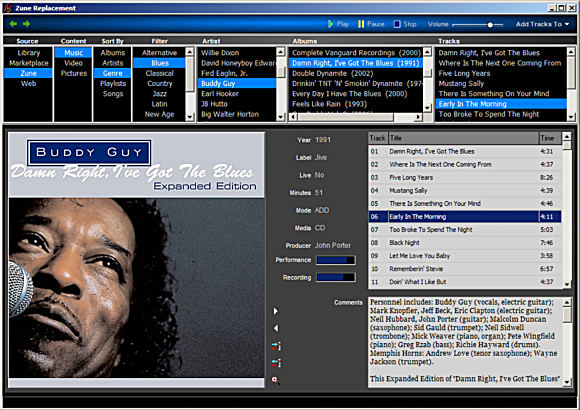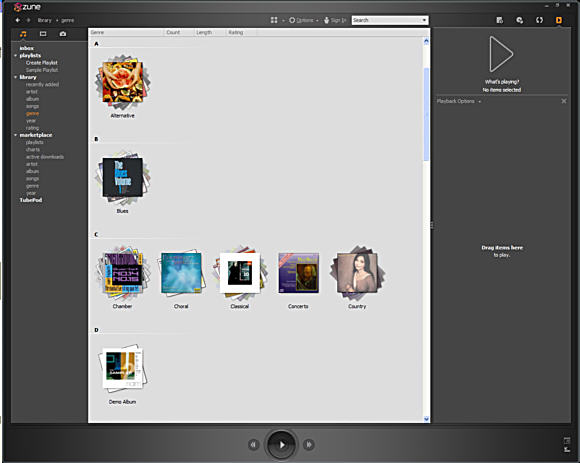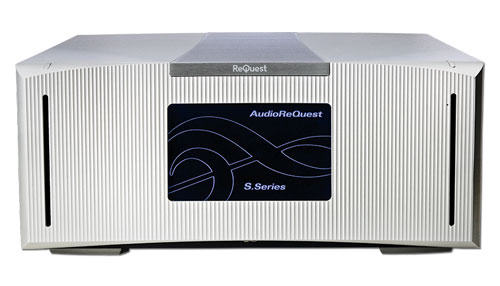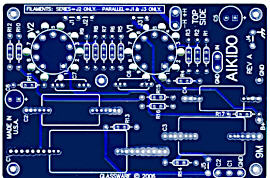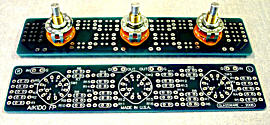| John Broskie's Guide to Tube Circuit Analysis & Design |
27 December 2006
Happy New Year. I am extending the Christmas sale until the end of the year, December 31st, 2006, as many are so busy right now with the holidays. Some calculating how much money they have left after Christmas; and a few lucky ones are tallying how much they received on Christmas. (Besides, I am too busy to go turn off the sale at the Yahoo! store.)
More Zune Thoughts
Second-rate is okay by me…or should I say, What should you listen to when only the best won’t do? Most classical aficionados place Beethoven and Bach at the very pinnacle of greatness (I, like so many others, dropped Brahms from the Three Bs long ago, although I greatly enjoy his music). These two composers sit on the highest thrones of artistic genius and one could devote a lifetime of careful listening to just their oeuvres. Yet, few do. Why? La Rochfoucauld wrote that, “Neither the sun nor death can be regarded steadily.” To this list, we can add all the greatest artistic triumphs. Complex and exhausting, listening to the entire Beethoven’s 9th Symphony requires a huge investment of time and effort. (Although this is one of my top-ten favorite pieces of music, I only listen to the whole of the work once every few years.) Beyond the rigorous demands made on us by the greatest works, the second-rate often proves more interesting. I believe it was T.S. Elliot who first pointed out that a great artist seldom creates a new artistic tradition; rather, he completes it, concluding, and exhausting a style or genre, mining and evacuating the last vein of artistic possibility. Shakespeare did not invent the tragedy, nor did Bach create the concerto. But after Shakespeare and Bach, no one wrote Shakespearean plays or composed Bach-like concertos. On the other hand, the lesser artist, eager to stake out his own artistic domain, invents wildly, indiscriminately, as creating the new is easier than mastering the old. As Eric Hoffer put it:
Moreover, any new fashion, whether in clothing (or lack of clothing; hello, Britney Spears), music, or politics (hello, Barack Obama), arrests our attention, if only briefly. (In audio, new distortions are more compelling than old distortions. To be successful—at least in the short run—in the high-end audio world, you do not have to produce a more accurate, cleaner-sounding piece of audio equipment, only a newly distorting device. As Woody Allen said in his Rip-Van-Winkle story, Sleeper, after tasting the food of the future, “This stuff tastes awful. I could have made a fortune selling it in my health food store.” Anyone ready for whale-oil and seaweed coupling capacitors? A bargain at only $1,200 each.) Do not get wrong here; I love silver. Sure, gold is wonderful, but silver is more practical. For example, I love Honda cars. Yes, Ferrari and Rolls Royce cars are great, but my Honda Fit and Odyssey are also great in a lesser, but more practical sense. I love Art Pepper, Dexter Gordon, Benjamin Britten, Alan Hovhaness, Arvo Pärt, and Dmitry Shostakovich—each is vastly talented, none is of the first order, although each is at the top of my play lists. Silver is just fine; tin and zinc are, of course, a different story. Well, the Zune and iPod perfectly suit the silver of the music world. Because they hold so much music, because navigating through the immense library is so easy, we are free to drop in and quickly examine the most interesting pieces of sonic silverware.
Practical Zune matters The Zune software falls into the zinc category. Too much is missing, too much is assumed. I would like to see two snapshots: one of what music resides on my computer and one of what is found on the Zune’s hard drive. I want to know what the percentages are for the genres on ether device. (For example, 43% Jazz, 0.002% Rap, 12% Folk…) I want to be able to choose the compression ratio used to encode each album, not a single universal ratio that applies to all albums. (For example, your phone is a very low-fi device, yet you can understand all that said to you through it. In the same way, spoken-word albums do not need the high-fidelity encoding that befits Beethoven or Bach.) But most of all, I want not only to know where I am in the music library, but where I came from and where I can go. In the name of all that is decent, it should never take longer to create a playlist than it takes to listen to it.
The above screen capture shows a replacement software program that I am writing for the Zune. It is not complete. How could it be? It took Microsoft several million dollars and hundreds of programmers, project managers, field testers and quality assurance technicians, and thousands and thousands of programmer-hours to create the overly-basic and partially-lame Zune program. In other words, it should take me about a month or two to finish this program. The goal is to be able to move easily and quickly through thousands of music tracks, hundreds of albums, many videos, and countless baby pictures. If I want to collect my favorite ten Buddy Guy songs or ten Blues songs, I shouldn’t have to wade through many screen refreshes and program back steps. I want to be able to filter the database so that only Jazz covers of “Summertime” show. Most importantly, I do not want any of the program’s real-estate wasted on vast stretches of white-space (in this case, black space), no matter how pretty.
The Zune player improvements A nice feature would be a 6-inch headphone line extension. Why? At some moment, you and your Zune will go in different directions. So, rather than having the headphone’s wires ripped from the plug, the headphones would just unplug from the extension. (Speaking of big screens, one crazy thought I had was to write a program that would convert text files into a series of image files, 320 by 240 pixels big, so that while waiting in line at the bank I can read essays that I have downloaded off the Web, something like Sony's eBook.)
Back to music By the way, the ear-buds that come with the Zune—like those that come with the iPod—stink. I recommend all of the Grado headphones, as they all sound good, although they are rather large and heavy. But the headphones that I use the most are the AKG K26Ps, which are also the most uncomfortable headphones that I have ever owned (as many must have guessed by now, I have a particularly fat head). So, why do I use them? For one, they fold up nicely; second, they acoustically seal off the outside world; finally, they sound surprisingly good. Many think nothing of spending thousands to make only the smallest increment in sonic improvement in there stereo systems. $3,000 power cords, for example. But for only $239 you can make an enormous increase in your enjoyment of your music collection. (Having filled up my Zune, if my wife wouldn’t think me crazy, I would love to buy a second one and to fill it with just classical music. A 60-Gig Zune would not be as good, as it would take much longer to access the songs and classical music has its own conventions and directory structure that best suit a separate device.)
Next time //JRB
|
High-quality, double-sided, extra thick, 2-oz traces, plated-through holes, dual sets of resistor pads and pads for two coupling capacitors. Stereo and mono, octal and 9-pin printed circuit boards available. Aikido PCBs for as little as $24 http://glass-ware.stores.yahoo.net/
The TCJ Stepped Attenuator The center knob controls both channels, and offers six large decrements; the flanking knobs offer six fine decrements for each channel, creating a volume control and balance control in one easy-to-use stepped attenuator. This clever attenuator uses fewer resistors (only 32) than would be expected from a conventional 32-position stepped attenuator, as two series attenuators would need a total of 72 resistors; and two ladder attenuators would require 140 resistors. In addition, the PCB holds dual sets of resistor pads, one wide and one narrow, so that axial (composition, wire-wound, and film) and radial (thick-film and bulk-foil) resistors can be used without extra lead bending. Although designed to go with the Aikido amplifier, it can be used anywhere a high-quality attenuator is needed, whether passive or active. For example, it would make a first-rate foundation to an excellent passive line box. Visit our Yahoo Store for more details: http://glass-ware.stores.yahoo.net/
The Tube CAD Journal's first companion program, TCJ Filter Design lets you design a filter or crossover (passive, solid-state or tube) without having to check out thick textbooks from the library and without having to breakout the scientific calculator. This program's goal is to provide a quick and easy display not only of the frequency response, but also of the resistor and capacitor values for a passive and active filters and crossovers. TCJ Filter Design is easy to use, but not lightweight, holding over 60 different filter topologies and up to four filter alignments: While the program’s main concern is active filters, solid-state and tube, it also does passive filters. In fact, it can be used to calculate passive crossovers for use with speakers by entering 8 ohms as the terminating resistance. Click on the image below to see the full screen capture. Tube crossovers are a major part of this program; both buffered and un-buffered tube based filters along with mono-polar and bipolar power supply topologies are covered. Available on a CD-ROM and a downloadable version (4 Megabytes). Download or CD ROM
|
|||
| www.tubecad.com Copyright © 1999-2006 GlassWare All Rights Reserved |

